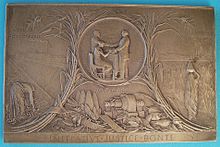| Nag Hammadi نجع حمادي | |
|---|---|
| City | |
 Aluminium Stadium in Nag Hammadi Aluminium Stadium in Nag Hammadi | |
 | |
| Coordinates: 26°03′N 32°15′E / 26.050°N 32.250°E / 26.050; 32.250 | |
| Country | |
| Governorate | |
| Area | |
| • Total | 103.9 sq mi (269.2 km) |
| Population | |
| • Total | 660,690 |
| • Urban | 61,737 |
| • Rural | 598,953 |
| Time zone | UTC+2 (EST) |
| • Summer (DST) | UTC+3 |

Nag Hammadi (/ˌnɑːɡ həˈmɑːdi/ NAHG hə-MAH-dee; Arabic: نجع حمادى Nagʿ Ḥammādī) is a city and markaz in Upper Egypt. It is located on the west bank of the Nile in the Qena Governorate, about 80 kilometres (50 mi) north-west of Luxor. The city had a population of close to 61,737 as of 2023.
History
The town of Nag Hammadi was found on the site of older villages Ansan (Arabic: انسان) and al-Luaqi (Arabic: اللواقي) in the 19th century and was named after its founder, Mahmoud Pasha Hammadi, a member of the Hammadi family in Sohag, Egypt. Mahmoud Pasha Hammadi was a major landholder in Sohag, and known for his strong opposition to the British rule in Egypt beginning in 1882.
In the city of Nag Hammadi, there is the palace of Prince Youssef Kamal, a member of the royal family (the family of Muhammad Ali Pasha), which overlooks the Nile River and is now an archaeological site.
Nag Hammadi is about 5 kilometres (3.1 mi) west of ancient Chenoboskion (Ancient Greek: Χηνοβόσκιον) The "Nag Hammadi library", an important collection of 2nd-century Gnostic texts, was found at Jabal al-Ṭārif near Nag Hammadi in 1945.
The city was the site of the Nag Hammadi Massacre in January 2010, in which eight Coptic Christians were shot dead by three men. In total, nineteen Coptic Christians were attacked.
Economy
Sugar and aluminium are produced in Nag Hammadi. The Nag Hammadi Sugar factory was built in 1895-1897 by French contractors Cail and Fives. It is still in operation in 2018. Egyptalum is one of the largest aluminium producer in the Middle East. Wood particleboard is manufactured from sugar cane bagasse.
See also
References
- "عدد السكان التقديري" (PDF). Retrieved 27 October 2023.
- "Carte geographique de l'Egypte et des pays environnans by Pierre Jacotin". PAThs – Archaeological Atlas of Coptic Literature. 1818.
- "Nag Hammadi palace re-opens". Ahram Online. 3 October 2019. Retrieved 27 October 2023.
- James M. Robinson (1988). The Nag Hammadi Library. San Francisco: Harper San Francisco.. "The Nag Hammadi Library consists of twelve books, plus eight leaves removed from a thirteenth book in late antiquity and tucked inside the front cover of the sixth. These eight leaves comprise a complete text, an independent treatise taken out of a book of collected essays". (p. 10). "nag-hammadi.com". Archived from the original on 2007-04-08.
- ^ "Egypt's anxious Copts 'await next catastrophe'" (25 January 2010) BBC News
- "Egypt church attack kills Copts". BBC News. 2010-01-07.
- Undated photo Wikimedia
| Egyptian cities by population | |
|---|---|
| 1,000,000 and more | |
| 300,000–999,999 | |
| 100,000–299,999 | |
| <99,999 | |
26°03′N 32°15′E / 26.050°N 32.250°E / 26.050; 32.250
Category: